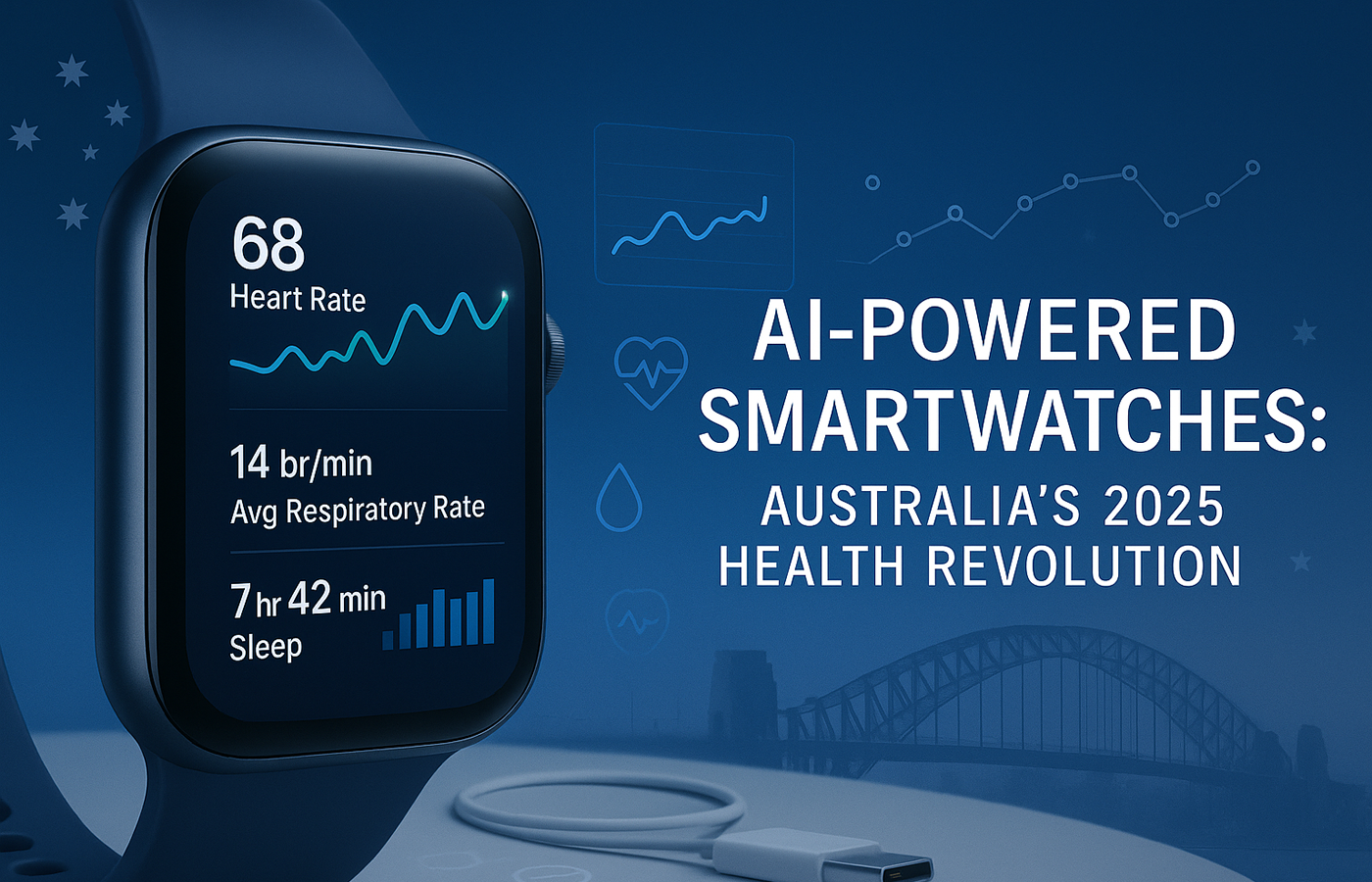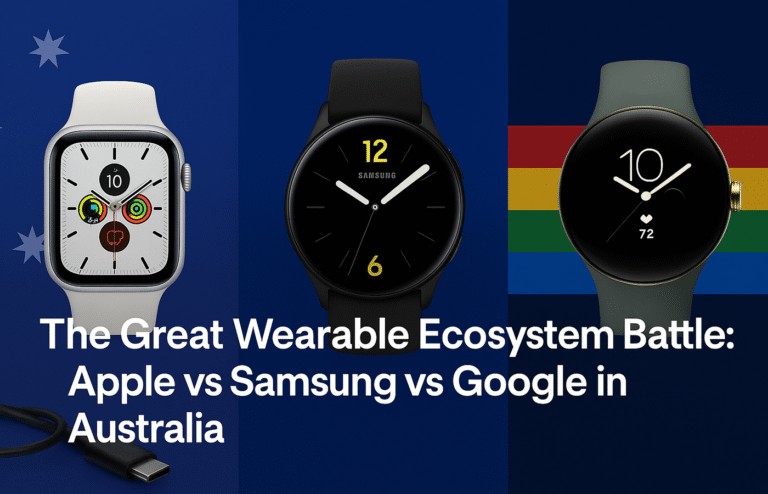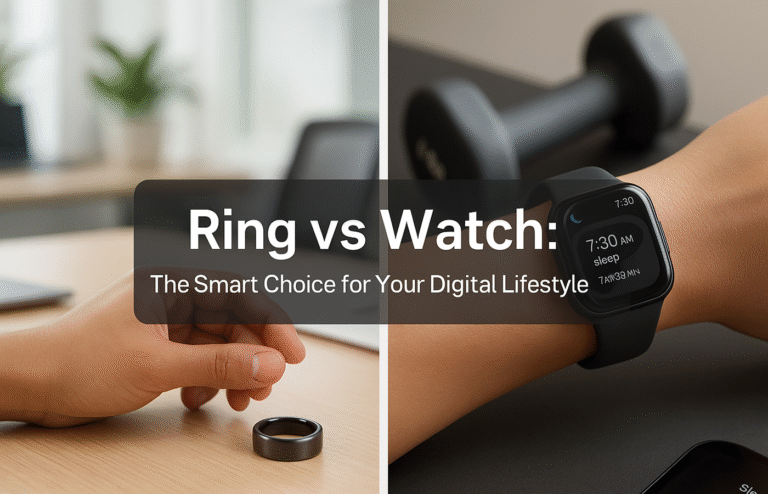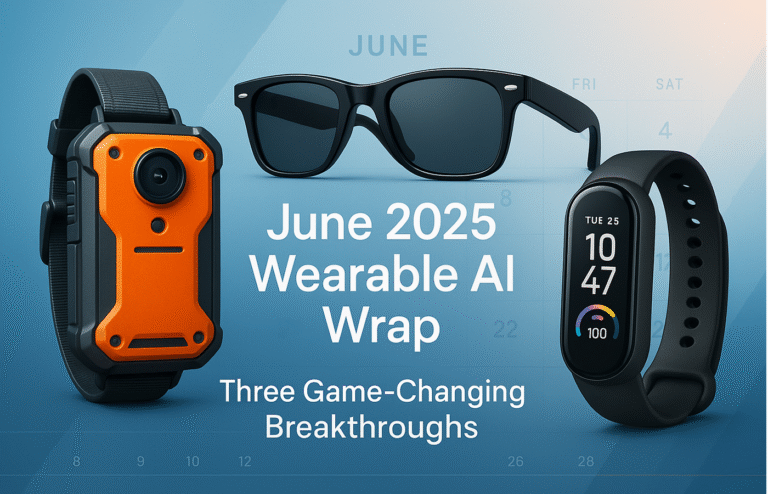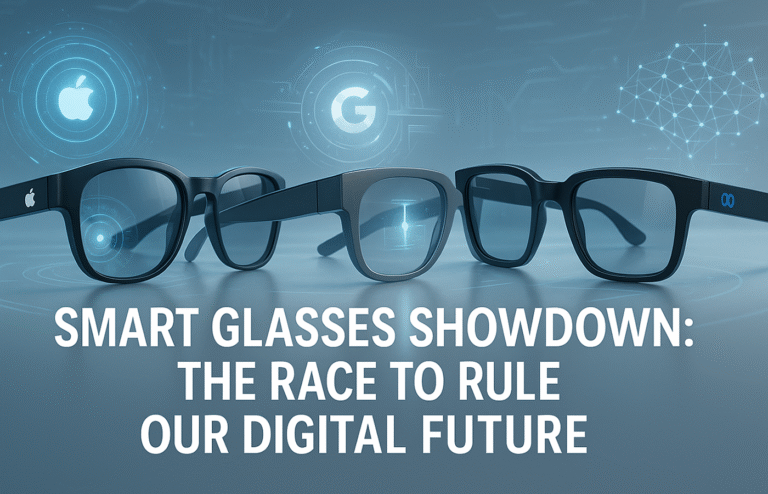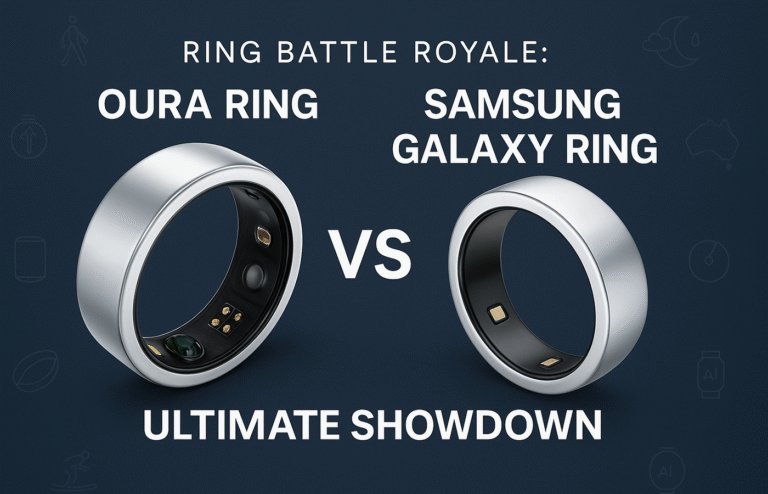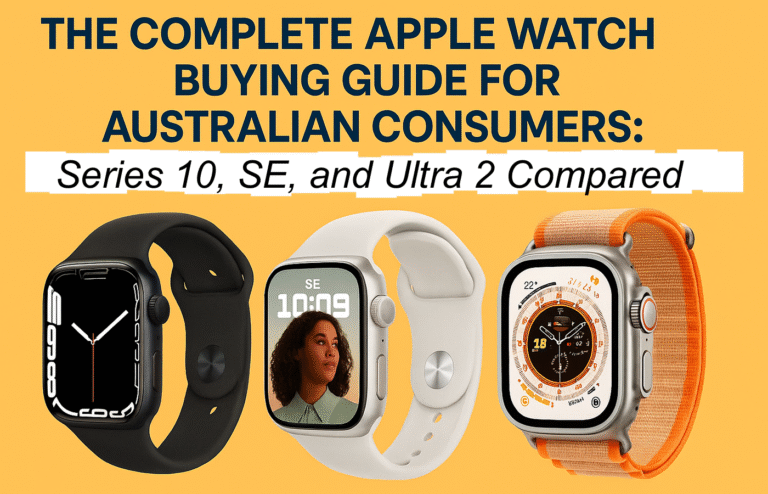AI Smartwatch Revolution: Australia’s 2025 Health Transformation Guide
AI-powered smartwatches have evolved from simple fitness trackers to sophisticated health companions offering predictive healthcare, with the wearable AI market growing at 29.8% CAGR through 2030.
Leading Innovation:
● Apple: HealthKit integration with Australian healthcare records and atrial fibrillation detection for 500,000+ affected Australians
● Samsung Galaxy Watch Ultra: Localised AI considering UV levels, pollen counts, and Australian air quality data
● Garmin Instinct 3 Series: Solar-powered displays with heat adaptation features for Australian climate conditions
Revolutionary Features:
● Predictive health monitoring identifying illness 2-3 days before symptoms appear
● Personalised workout optimisation factoring bushfire smoke and UV exposure
● Mental health monitoring accounting for 15% of wearables market usage
2025 Advantages: Technological maturity, healthcare system integration, 5G connectivity, and regulatory framework development create optimal adoption conditions.
AI-Powered Smartwatches: Australia’s 2025 Health Revolution
The smartwatch landscape has transformed dramatically over the past year, with artificial intelligence moving from a marketing buzzword to a genuine game-changer in personal health monitoring. For Australian consumers, 2025 represents a pivotal moment where AI-powered smartwatches are no longer just fitness trackers—they’re becoming sophisticated health companions that can predict, prevent, and personalize healthcare in ways previously reserved for medical professionals.
The Evolution from Tracking to Predicting
Traditional smartwatches counted steps and measured heart rate. Today’s AI-powered devices analyze patterns, predict health events, and provide actionable insights that can genuinely save lives. The wearable AI market shows remarkable growth projections with expected growth at a CAGR of 29.8% from 2023 to 2030, and smartwatches are leading this charge.
The transformation is most evident in how these devices now handle health data. Instead of simply displaying your current heart rate, modern AI algorithms analyze heart rate variability patterns over weeks and months, identifying subtle changes that might indicate stress, illness, or the need for medical attention. This shift from reactive to predictive healthcare represents a fundamental change in how we approach personal wellness.
Major Players Driving Innovation
Apple’s Health Intelligence Revolution
Apple continues to set the standard with its latest Watch Series, incorporating advanced AI features that work seamlessly with Australia’s healthcare ecosystem. Apple is exploring adding cameras and visual intelligence features to its smartwatch, entering the AI wearables market. The company’s HealthKit integration now supports Australian health records, making it easier for users to share wearable data with their GPs and specialists.
The standout AI feature is the watch’s ability to detect irregular heart rhythms and potential atrial fibrillation—a condition affecting over 500,000 Australians. The AI doesn’t just alert users to irregularities; it learns individual patterns and reduces false alarms while ensuring genuine concerns are flagged appropriately.
Samsung’s Ecosystem Approach
In July 2024, Samsung revealed its first-ever premium smartwatch and smart ring, marking its entry into a niche market with AI capabilities aimed at helping users monitor and manage their health. Samsung’s Galaxy Watch Ultra demonstrates how AI can optimize the entire user experience, from automatically adjusting workout intensity based on recovery metrics to predicting optimal sleep windows based on daily activity patterns.
For Australian Samsung users, the integration with Samsung Health provides AI-driven insights that consider local factors like UV levels, pollen counts, and air quality data from Australian environmental monitoring systems. This localized approach makes Samsung’s AI particularly relevant for Australian conditions.
Garmin’s Athletic Intelligence
Garmin has carved out a unique position by focusing AI development on serious athletes and outdoor enthusiasts. In January 2025, Garmin announced the launch of its Instinct® 3 Series, a new lineup of rugged smartwatches featuring either a brilliant AMOLED or solar-powered display for extended battery life. Their AI algorithms excel at training optimization, analyzing performance data to recommend rest periods, suggest workout modifications, and predict race performance.
Australian athletes particularly benefit from Garmin’s AI-powered heat adaptation features, which factor in Australia’s extreme temperature variations to optimize training schedules and prevent heat-related injuries. The technology learns individual heat tolerance and adjusts recommendations accordingly—crucial for Australian conditions.
Revolutionary AI Features Changing Healthcare
Predictive Health Monitoring
Modern AI-powered smartwatches don’t just monitor—they predict. Advanced algorithms analyze sleep patterns, heart rate variability, activity levels, and even subtle changes in walking gait to identify potential health issues before symptoms appear. Some devices can now predict illness onset 2-3 days before users feel unwell, allowing for early intervention.
This predictive capability is particularly valuable in Australia’s healthcare system, where accessing specialists can involve lengthy wait times. Early detection through wearable AI can help users seek appropriate care sooner and provide doctors with detailed baseline data for more accurate diagnoses.
Personalized Workout Optimization
AI-powered fitness coaching has evolved beyond generic recommendations to truly personalized guidance. These systems analyze individual fitness levels, recovery patterns, sleep quality, and even nutrition data to create dynamic workout plans that adapt daily based on the user’s current physical state.
Australian fitness enthusiasts benefit from AI algorithms that consider local environmental factors. The technology can automatically adjust workout intensity on high UV days, modify outdoor exercise recommendations during bushfire season, or suggest indoor alternatives when air quality is poor.
Mental Health and Stress Management
Mental Health Monitoring: Devices using biometric sensors to monitor stress, mood, and emotional well-being accounted for 15% of the overall wearables market in 2023. AI-powered stress detection has become increasingly sophisticated, using multiple biometric indicators to provide a comprehensive picture of mental wellness.
These features are particularly relevant given Australia’s focus on mental health awareness. The AI can identify stress patterns related to work schedules, suggest mindfulness sessions during high-stress periods, and even detect signs of anxiety or depression that might warrant professional attention.
Australian Healthcare Integration Opportunities
Medicare and Digital Health Integration
The Australian government’s digital health initiatives are creating new opportunities for wearable AI integration. While full Medicare integration remains in development, pilot programs are exploring how wearable data can inform preventive care strategies and support chronic disease management.
AI-powered smartwatches could potentially contribute to health assessments, medication adherence monitoring, and early intervention programs. This integration would be particularly valuable for managing conditions common among Australians, such as cardiovascular disease and diabetes.
Professional Healthcare Adoption
Australian healthcare professionals are increasingly recognizing the value of patient-generated health data from AI-powered wearables. Cardiologists can now review months of heart rhythm data before appointments, while sleep specialists can analyze detailed sleep architecture patterns to improve treatment outcomes.
The AI’s ability to filter and highlight concerning patterns saves healthcare professionals time while providing more comprehensive patient insights than traditional consultation-based assessments alone.
Challenges and Considerations for Australian Users
Data Privacy and Sovereignty
With increasing AI sophistication comes greater data sensitivity. Australian users should understand how their health data is processed, stored, and shared. On-Device AI dominated the market with over 58% share in 2022 and is expected to hold high market share due to burgeoning demand for instantaneous, privacy-centric processing.
Choosing devices that prioritize on-device processing can help address privacy concerns while ensuring data remains within Australian jurisdiction where possible.
Clinical Validation and Accuracy
While AI-powered features are impressive, Australian users should understand the limitations. Not all AI health insights have clinical validation, and wearable devices shouldn’t replace professional medical advice. However, they can serve as valuable supplementary tools for health monitoring and early detection.
Battery Life and Reliability
Wearable AI devices have lower battery span and short operational life compared to conventional electronics. AI processing demands significant power, and Australian users need devices that can maintain functionality throughout long workdays or outdoor adventures. Solar charging capabilities, like those in Garmin’s latest devices, address this challenge for outdoor enthusiasts.
The 2025 Tipping Point: Why Now?
Several factors are converging to make 2025 the breakthrough year for AI-powered smartwatches in Australia:
Technological Maturity: AI algorithms have reached sufficient sophistication to provide genuinely useful health insights rather than basic data presentation.
Healthcare System Pressure: Australia’s healthcare worker shortages and aging population create demand for preventive health technology that can reduce system burden.
Consumer Readiness: Australians have become comfortable with health data sharing and understand the value of continuous monitoring, accelerated by pandemic experiences.
Infrastructure Support: 5G networks and improved rural connectivity enable more sophisticated AI processing and real-time health monitoring capabilities.
Regulatory Framework: Australian health authorities are developing frameworks for integrating wearable data into healthcare delivery, creating pathways for broader adoption.
Choosing the Right AI-Powered Smartwatch for Australian Conditions
For Healthcare Professionals: Apple Watch Series offers the most comprehensive health monitoring with strong ecosystem integration and professional-grade heart monitoring capabilities.
For Fitness Enthusiasts: Garmin devices provide superior AI-powered training optimization and environmental adaptation features crucial for Australian outdoor conditions.
For Technology Adopters: Samsung Galaxy Watch Ultra offers cutting-edge AI features with excellent integration for existing Samsung device users.
For Battery Life Priority: Consider devices with solar charging capabilities, particularly important for Australian outdoor lifestyles and remote area usage.
The Future of Wearable AI in Australia
As we move through 2025, expect to see even more sophisticated AI features emerging. Continuous glucose monitoring integration, advanced sleep disorder detection, and predictive medication management are all on the horizon. Australian-specific developments might include bushfire smoke detection alerts, UV exposure optimization, and integration with local emergency services.
The convergence of advancing AI technology, healthcare system needs, and consumer adoption creates a perfect storm for smartwatch innovation. For Australian consumers, this represents an unprecedented opportunity to take control of their health with technology that’s finally sophisticated enough to make a real difference.
AI-powered smartwatches are no longer optional accessories—they’re becoming essential health tools. The question isn’t whether to adopt this technology, but which device best fits your lifestyle and health goals. As these devices become more intelligent and integrated with Australian healthcare systems, early adopters will benefit from better health outcomes and more informed healthcare decisions.
The revolution is here, and it’s happening on your wrist.

